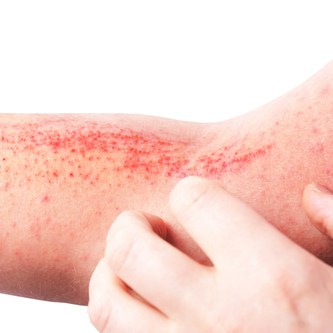What are migraines and tension headaches?
Migraine and tension-type headaches are the two most common forms of primary headache. Primary headaches are not associated with another disease state, but are likely the result of a complex interplay of hereditary and environmental factors. Studies have demonstrated a polygenetic component to primary headaches, with multiple mutations noted and a likely link to the X chromosome.
There is also a correlation with motion sickness because motion sickness and migraines share a gene. The initial onset of migraine and tension-type headaches typically occurs in childhood or early adulthood. Individuals of any age with motion sickness are more likely to develop migraine.
Most primary headaches are caused by a complex neurovascular event. Normally, there is a balance between excitation and the inhibition of the nervous system. However, when that balance is disturbed, it can result in a headache.
Related: Migraine and Tension Headache: The Latest Treatment Recommendations
Are migraines and tension-type headaches two different conditions?
Historically, healthcare professionals had believed migraine and tension-type headaches to be two different conditions, with some patients having a component of both. A more contemporary perspective is that these headaches occur across a pathologic continuum. As a result, most people with migraine will have a component of tension-type headache and those with tension-type headache will occasionally exhibit migraine features.
Patients will normally have a predominant headache type, This is an important reframing because knowing this helps healthcare providers to work with patients and stay open-minded with treatment options depending on a particular patient’s presentation.
What are the symptoms reported in primary headache?
A study conducted of migraine sufferers found that many patients shared their most bothersome symptoms (MBS), aside from headache pain.
- Photophobia (49.1%)
- Nausea (28.1%)
- Phonophobia (22.8%)
In migraines, patients also experience:
- Pulsing head pain of moderate to severe intensity
- Usually unilateral, occasionally bilateral
- Up to 80% will also report sinus pressure/pain during the headache due to the innervation of the trigeminal nerve.
- =>1 notation of the following:
- Nausea/vomiting, photophobia, or phonophobia
In tension-type headaches, patients typically experience:
- Pressing, non-pulsating pain, usually bilateral, mild to moderate in intensity
- A report of 0-1 of the following:
- Nausea, photophobia, or phonophobia
What are acute treatment options for migraines and tension headaches?
The goals of treating acute headaches are to:
- Restore the patient’s ability to function.
- Treat attacks rapidly, consistently, and without recurrence
- Minimize the use of backup and rescue medications (especially those only available in emergency medicine situations, including injectable products.)
Acute, also known as abortive, migraine treatments are most effective when taken early in the course of the headache. The most commonly used acute/abortive headache therapies include the following:
- Nonspecific analgesics including acetaminophen and NSAIDS (including rapid-onset products such as ibuprofen or naproxen sodium or aspirin).
Many oral medications are ineffective because of poor absorption secondary to migraine-induced gastric status. This is one of the reasons it is helpful to go with liquid acetaminophen or NSAID.
Triptans, gepants, and ditans
Migraine-specific medications include:
- Triptans (oral, nasal, injectable)
- Triptans should be prescribed to patients who have mild to substantial disabilities, particularly MBS, with headache who do not respond to the non-headache specific products such as NSAIDs and acetaminophen.
- The triptans have a profile of decades of safety with use. However, this drug class should not be used in individuals with cardiovascular disease or uncontrolled hypertension.
- The triptans are available to be delivered orally, including the rapidly dissolving tablets, or via injection or nasal spray. This allows for flexibility of use, particularly when GI upset is a significant part of the patient’s migraine.
- A triptan/NSAID or acetaminophen combination typically provides more symptoms relief when compared to using a triptan alone. Typically, prescribing one large dose of a medication at headache onset, such as ibuprofen 600-800 mg and/or sumatriptan 50-100 mg is more effective than lower doses.
- Orally or nasally administered CGRP antagonists
- This drug class is also known as the gepants, owing to the fact that the members of the drug class have a -gepant suffix in their generic names. Examples include orally administered options such as ubrogepant (Ubrelvy) and rimegepant (Nurtec), as well as available zavegepant (Zavzpret), available as an oral tablet or nasal spray. Select members of the oral CGRP antagonists are also FDA approved from use in migraine prevention.
- The CGRP antagonists for as an acute/abortive headache therapy are particularly well suited for patients who fail to improve with triptan therapy, particularly when combined with NSAID or acetaminophen. Due to cost, seldom are the gepants considered first-line therapy.
- This drug class has been used in patients with triptan contraindications, including cardiovascular issues. The drug class has not been studied for use in pregnancy and lactation.
- Oral selective 5HT1F receptor agonist
- This drug class is also known as the ditans, given the drug’s generic name suffix. The mechanism of action of this drug class is more receptor-site specific when compared to the triptans, potentially minimizing some of the triptan adverse effects including vasoconstriction.
- Currently, there is only one ditan available, lasmiditan (Reyvow), available orally. Due to potential abuse risk, this drug is a Schedule V controlled substance. Patients may only take 1 dose in 24 hours.
- Due to altered cognition and sedation risk, patients should not take lasmiditan if unable to wait 8 hours to drive or operate machinery post dose. The ditans for an acute/abortive headache therapy are particularly well suited for patients who fail to improve with triptan therapy, particularly when combined with NSAID or acetaminophen. Due to cost, seldom are the ditans considered first-line therapy.
Additional therapies include dihydroergotamine (DHE) nasal spray or injection and metoclopramide. These are typically reserved for use in patients with severe acute migraines who have not responded to triptans in the past. The prescriber needs to be well-versed in the special considerations with these medications.
When are prophylaxis therapies appropriate for frequent headache sufferers?
Prophylaxis is indicated when the patient has any or all of the following:
- Two or more headaches per month
- Two or more per week is definitely indicated
- Two or more days of disability per month
- Overuse, intolerance, or refractory of abortive/acute headache agents
Goals for prophylactic therapy include:
- Reduce the frequency of headaches
- Reduce the severity of headaches
- Allow headache medications to work more effectively
- Rarely does it eliminate headaches entirely, but it does provide a 50% reduction in two-thirds of patients
What are prevention therapies for migraines and tension headaches?
A variety of non-headache specific medications, including select beta-blockers, antiepileptic drugs, and nutritional supplements, have been documented to have effectiveness in preventing headache. One advantage of these medications is reasonable cost. As a result of these factors, these medications are usually the first-line products for headache prevention. Generally, about 4-6 weeks of use is needed prior to the patient noticing significant headache reduction.
The following beta-blockers have strong evidence of efficacy for headache prophylaxis:
- Beta-adrenergic antagonist examples:
- Propranolol: Noncardioselective, do not use in patients with airway disease
- Metoprolol: Cardioselective, preferred for patients with airway disease
The following antiepileptic drugs have strong evidence of efficacy for headache prophylaxis, though all carry a teratogenic risk as well as potential cognitive impairment.
Antiepileptic drugs examples include:
- Divalproex sodium
- Sodium valproate
- Topiramate
Additional migraine-specific medications
Migraine-specific medications are available to help prevent headaches. In part due to cost, these medications are typically used with the above-mentioned medications are not helpful and/or not tolerated. These migraine-specific medications are well tolerated and have a quicker onset of action in headache reduction when compared to the non-headache specific medications, usually within 2 weeks of starting the drug.
CGRP is a small neuropeptide found at the ends of nerves and embedded in blood vessels and can play a role in vasodilation and pain signaling two contributors to headache generation. A number of medications that block CGRP have been developed and are effective for headache prevention and well-tolerated. These CGRP-specific medications are divided into two groups: injectable products that are monoclonal antibody derived and select oral gepants. These medications have not been studied extensively in pregnancy and lactation.
The injectable CGRP-specific medications are given every 1 to 3 months, depending on the drug. There are few contraindications to use. The -mab suffix on each product confirms these are monoclonal antibody derived. Examples of the injectable products include the following:
The gepants, most often used orally, block the CGRP receptor. While used to treat acute headaches, some members of this drug class are also approved for prevention therapy. As with gepant oral use, clinicians should keep drug interaction potential in mind. Examples of gepants approved for both acute and preventive headache therapy include the following:
What lifestyle modifications can help prevent headaches?
Patients are able decrease the frequency of migraines with lifestyle changes. Regular exercise and hydration are two helpful suggestions to provide to patients suffering from headaches. Maintaining a regular sleep schedule is also helpful. Keeping a headache diary to help recognize patterns and triggers can be revealing, especially in avoiding headache triggering foods and beverages.
Earn CE hours with the Migraine and Tension Headache online course (free with Passport Membership)!




